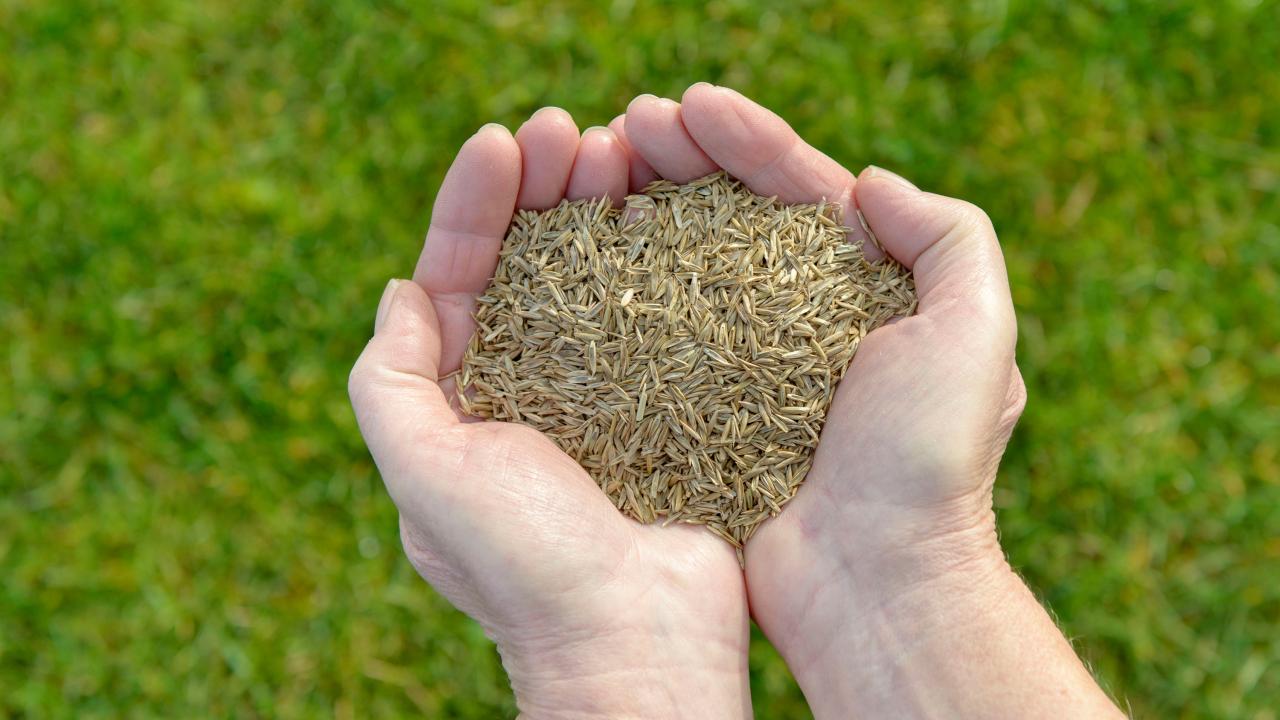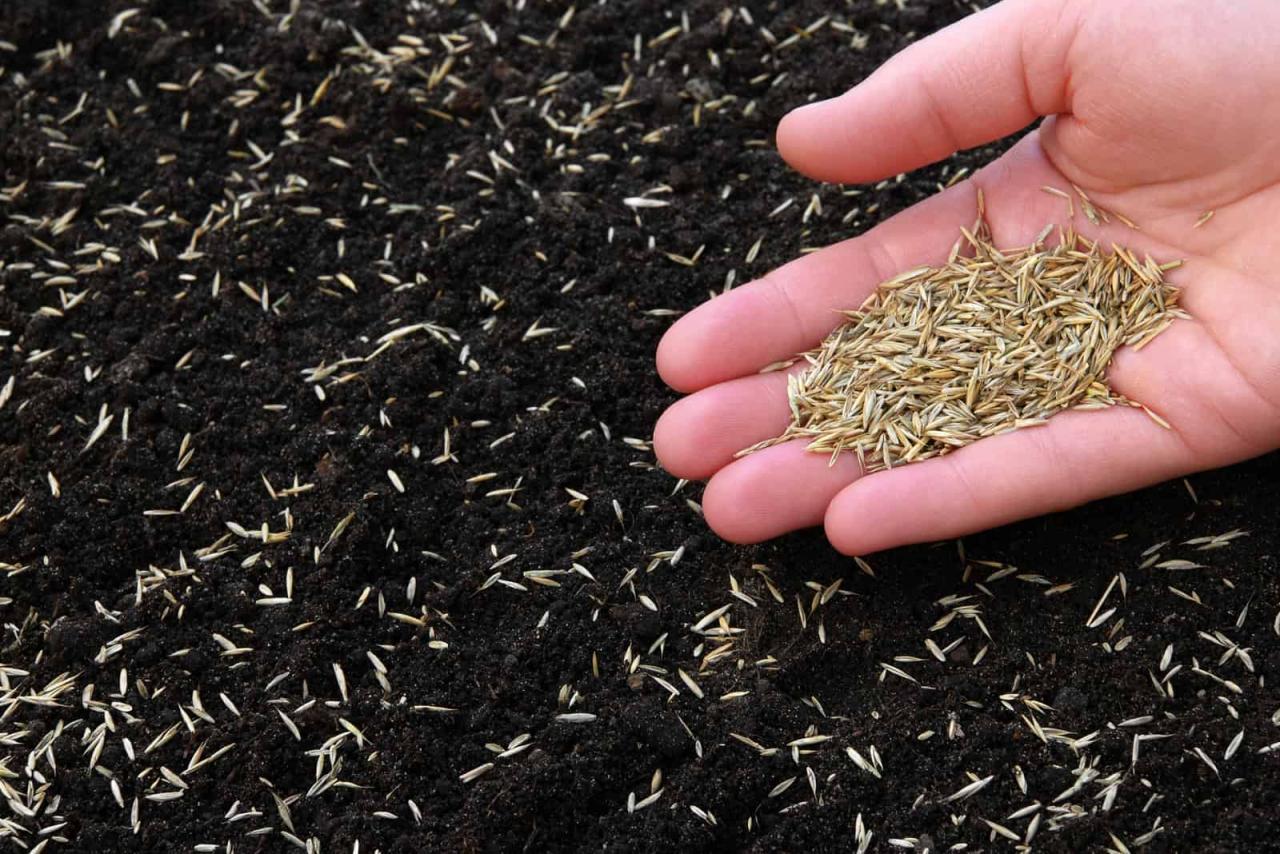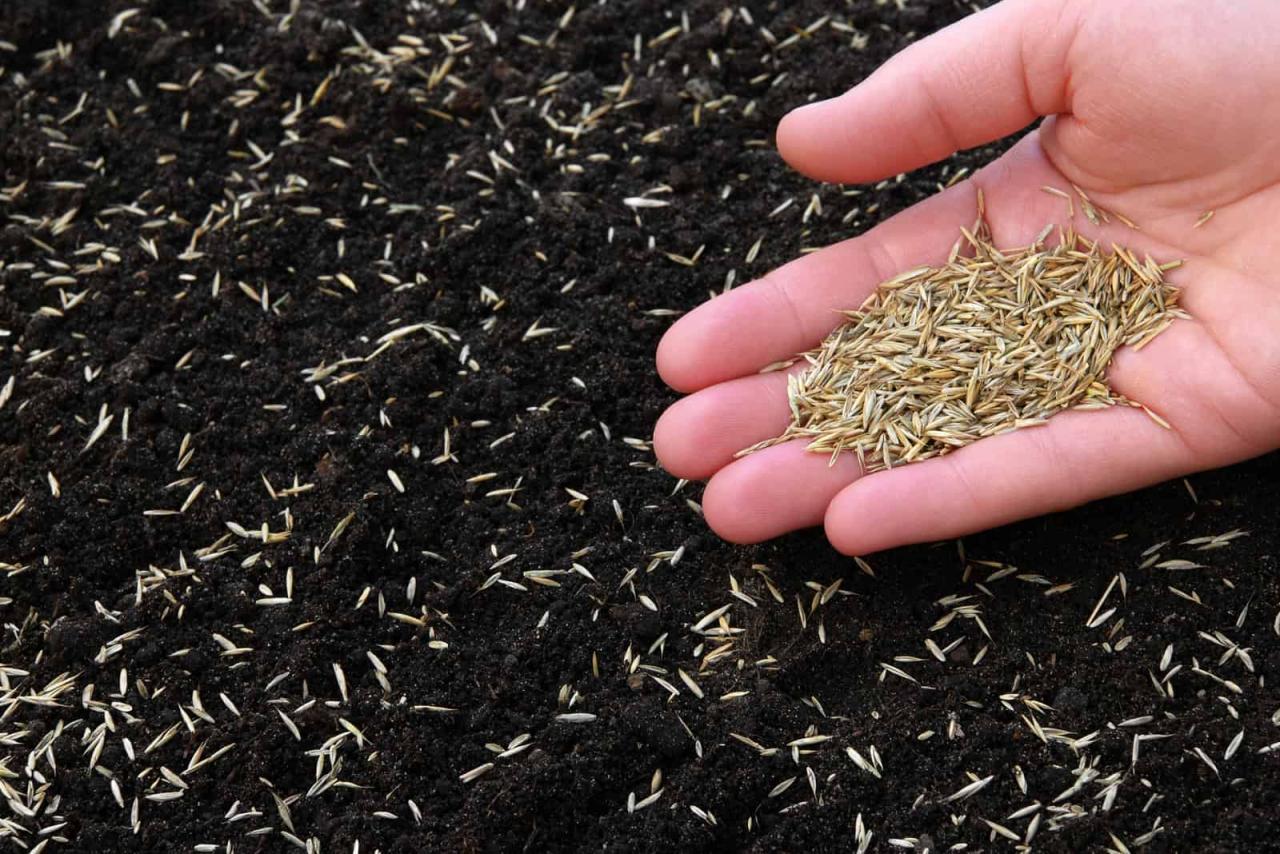When to Sow Grass Seed for a Stunning and Healthy Lawn: Essential Timing Advice – a lush, vibrant lawn isn’t just about aesthetics; it’s about creating a healthy, thriving ecosystem that benefits both your home and the environment. The timing of your grass seed sowing plays a crucial role in determining its success, influencing everything from germination rates to the overall health of your lawn.
Understanding the nuances of seasonal variations, soil conditions, and grass seed types is key to achieving a beautiful and resilient lawn. This guide will delve into the optimal times for sowing grass seed in different climates, providing insights into the factors that influence success, and offering essential tips for preparing your soil, selecting the right seed, and caring for your new lawn.
Understanding the Importance of Timing
Timing is everything when it comes to sowing grass seed. The success of your lawn depends heavily on when you plant the seeds, as different seasons offer varying conditions for germination and growth.
Optimal Timing for Grass Seed Germination and Growth
Choosing the right time to sow grass seed can significantly impact its success. Understanding the benefits of sowing during ideal periods and the potential downsides of planting during unsuitable times is crucial.
- Spring:Spring is a popular time to sow grass seed, especially in cooler climates. The soil is warming up, providing ideal temperatures for germination. The days are lengthening, giving seedlings ample sunlight for photosynthesis. However, spring can also be unpredictable, with potential for late frosts that can damage young seedlings.
- Fall:Fall is often considered the best time to sow grass seed. Temperatures are still warm enough for germination, but the cooler nights help to retain moisture in the soil. The reduced heat stress and less competition from weeds make fall an ideal time for establishing a strong root system.
Ideal Time for Spring Seeding
Spring is the ideal time to sow grass seed in many regions, as the soil warms up and the weather becomes more favorable for germination and growth. However, the optimal timeframe for spring seeding varies depending on your specific climate zone.
Spring Seeding Timeframes by Climate Zone
The optimal time for spring seeding is when the soil temperature reaches a consistent 50°F (10°C) at a depth of 2 inches. This temperature allows for proper seed germination and root development. Here are some general guidelines for different climate zones:
- Warm Climates (USDA Zones 8-10):Early spring, from February to March, is the best time to sow grass seed in warm climates.
- Moderate Climates (USDA Zones 5-7):Mid-spring, from March to April, is the ideal time for seeding in moderate climates.
- Cool Climates (USDA Zones 3-4):Late spring, from April to May, is the optimal time to sow grass seed in cool climates.
Preparing the Soil for Spring Seeding
Proper soil preparation is crucial for successful spring seeding. Here are some essential steps:
- Remove Existing Vegetation:Clear the area of any existing grass, weeds, or debris. You can use a dethatcher, rake, or even a sod cutter to remove existing vegetation.
- Test Soil pH:Conduct a soil test to determine the pH level. Grass thrives in slightly acidic soil with a pH between 6.0 and 7.0. Adjust the pH as needed using lime or sulfur.
- Amend the Soil:Incorporate organic matter, such as compost or aged manure, to improve soil structure, drainage, and nutrient content.
- Till or Rake:Till or rake the soil to a depth of 4-6 inches to create a fine, loose seedbed.
Ensuring Proper Seed Depth
The depth at which you sow grass seed significantly impacts germination. Here’s how to ensure proper seed depth:
- Follow Seed Package Instructions:Most seed packages provide specific instructions on the recommended seeding depth.
- General Guideline:As a general rule, sow grass seed at a depth of 1/4 to 1/2 inch.
- Use a Seed Spreader:A seed spreader helps distribute the seed evenly and at the appropriate depth.
Caring for Newly Seeded Lawns in Spring
Once you’ve sown your grass seed, it’s crucial to provide the proper care to ensure successful germination and establishment.
- Water Regularly:Keep the soil consistently moist, but not waterlogged. Water deeply and infrequently, aiming for 1 inch of water per week.
- Avoid Foot Traffic:Minimize foot traffic on the newly seeded area to prevent disturbing the seedlings.
- Mow When Needed:Once the grass reaches a height of 3-4 inches, mow it at a height of 2-3 inches.
- Fertilize:Apply a starter fertilizer to provide essential nutrients for the young grass.
Fall Seeding
Fall seeding offers several advantages over spring seeding, making it a favorable choice for establishing a healthy and vibrant lawn. Cooler temperatures and increased rainfall during fall create ideal conditions for seed germination and root development.
Fall Seeding Timeframe
The ideal timeframe for fall seeding varies depending on your climate zone. Generally, it’s best to seed about 6-8 weeks before the first expected frost. This allows the grass seedlings to establish a strong root system before winter sets in.
- Northern Regions:Aim to seed between mid-August and mid-September.
- Mid-Latitude Regions:Seed between early September and late October.
- Southern Regions:Seeding can extend into November, depending on the specific climate.
Preparing the Soil
Proper soil preparation is crucial for successful fall seeding. This involves:
- Removing Existing Vegetation:Clear the area of any existing grass or weeds by mowing low and removing debris. You can also use a dethatcher to remove thatch buildup, which can hinder seed germination.
- Testing Soil pH:A soil test will determine if your soil needs amendments to reach the optimal pH for grass growth, which is typically between 6.0 and 7.0.
- Aerating the Soil:Aeration helps improve drainage and allow roots to penetrate deeper, which is essential for healthy lawn development.
- Adding Organic Matter:Incorporate compost or aged manure into the soil to improve its structure and fertility. This will provide essential nutrients for the developing grass seedlings.
- Raking and Leveling:Rake the soil smooth to create a consistent seedbed, and level any uneven areas.
Caring for Newly Seeded Lawns in Fall
Once you’ve seeded your lawn, it’s important to provide the right care to ensure successful germination and establishment:
- Watering Regularly:Keep the soil consistently moist but not soggy. Water deeply and infrequently, aiming for 1 inch of water per week.
- Avoid Foot Traffic:Minimize foot traffic on the newly seeded area to prevent disturbing the seedlings.
- Protect from Pests and Diseases:Monitor for pests and diseases and address any issues promptly to prevent damage to the developing lawn.
- Fertilizing:Apply a starter fertilizer specifically formulated for new lawns to provide essential nutrients for growth.
Factors Influencing the Best Seeding Time

The success of your lawn seeding venture hinges on understanding the factors that influence grass seed germination. Timing is crucial, and several environmental variables play a significant role in determining the best time to sow your grass seed.
Temperature
Temperature is a key factor influencing grass seed germination. Each grass species has an optimal temperature range for germination. Cool-season grasses, such as Kentucky bluegrass, fescue, and ryegrass, germinate best in cooler temperatures, typically between 60°F and 75°F (15°C and 24°C).
Warm-season grasses, such as Bermuda grass and zoysia grass, prefer warmer temperatures, generally between 75°F and 90°F (24°C and 32°C).
For optimal germination, ensure the soil temperature is within the ideal range for your chosen grass type.
Sunlight
Sunlight is essential for photosynthesis, the process by which plants convert light energy into chemical energy for growth. Most grasses require at least six hours of direct sunlight per day for healthy growth. When choosing a seeding time, consider the amount of sunlight your lawn receives.
If your lawn is shaded for a significant portion of the day, you may need to select a shade-tolerant grass species.
Rainfall
Rainfall plays a crucial role in grass seed germination and establishment. Adequate moisture is necessary for the seed to germinate and develop a strong root system. If rainfall is insufficient, you may need to water your newly seeded lawn regularly to maintain soil moisture.
Aim for 1 inch of water per week, applying it slowly and deeply to encourage root development.
Soil Type
Soil type significantly impacts the best time to sow grass seed. Clay soils, for instance, tend to retain moisture, which can lead to poor drainage and slow germination. Sandy soils, on the other hand, drain quickly, potentially leading to seed drying out.
- Clay soils: Spring seeding is often preferred for clay soils, as the soil is typically moist from winter rains and has had time to warm up.
- Sandy soils: Fall seeding is often recommended for sandy soils, as the cooler temperatures and higher humidity provide a more favorable environment for germination.
Weed Competition
Weed competition can hinder grass seed germination and establishment. Weeds compete for nutrients, water, and sunlight, making it challenging for new grass to establish itself.
Control weeds before seeding to give your new grass the best chance of success.
Essential Tips for Successful Seeding
Timing is crucial for successful grass seeding, but it’s equally important to prepare the soil properly. The condition of your soil directly impacts the germination and growth of your new lawn. Here’s a step-by-step guide to preparing the soil before seeding.
Preparing the Soil for Seeding
A well-prepared soil provides a suitable environment for grass seed to germinate and establish a strong root system. Here are the essential steps involved in preparing the soil:
- Remove Existing Vegetation:Clear the area of any existing grass, weeds, or debris. You can use a sod cutter, tiller, or even a manual method like hand pulling to remove existing vegetation.
- Test Soil pH:Grass thrives in a slightly acidic soil pH of 6.0 to 7.0. Use a soil testing kit to determine your soil’s pH. If the pH is too high, you can amend it with sulfur. If it’s too low, you can use lime to raise the pH.
Timing is crucial for a successful lawn, and just like knowing when to sow grass seed, understanding the right time to propagate plants can significantly impact their growth. For instance, if you’re looking to quickly and easily expand your ivy collection, check out this guide on How to Propagate Ivy in Just a Few Days – Quick and Easy Steps.
Back to your lawn, the ideal time for seeding varies based on your region’s climate, so research the best window for your area for optimal germination and a healthy, thriving lawn.
- Till or Rake:Loosen the soil to a depth of 4 to 6 inches. This allows the seed to come into contact with the soil and promotes root growth. Use a tiller or rake to break up compacted soil and remove any remaining debris.
- Incorporate Organic Matter:Add compost or aged manure to improve soil structure, drainage, and nutrient content. This enriches the soil and provides a healthy environment for grass growth.
- Level the Soil:Ensure a level surface for even seed distribution and water penetration. Use a rake or landscaping tools to level the soil and remove any bumps or dips.
- Compact the Soil:Lightly compact the soil after leveling to create a firm base for the seed. This prevents the seed from being washed away by rain or irrigation.
Grass Seed Types and Suitability
Selecting the right grass seed type is crucial for a successful lawn. Different types of grass have varying characteristics, such as growth habits, shade tolerance, and drought resistance. This table provides a comparison of different grass seed types and their suitability for various climates and soil conditions.
Grass Type |
Climate |
Soil Type |
Characteristics |
|---|---|---|---|
Kentucky Bluegrass |
Cool-season |
Clay, loam |
Dense, dark green, disease resistant |
Perennial Ryegrass |
Cool-season |
Loam, sandy loam |
Fast-growing, good for overseeding |
Fine Fescue |
Cool-season |
Sandy, acidic |
Shade tolerant, low maintenance |
Tall Fescue |
Cool-season |
Clay, loam |
Drought tolerant, low maintenance |
Bermuda Grass |
Warm-season |
Sandy loam |
Fast-growing, heat tolerant |
Zoysia Grass |
Warm-season |
Clay, loam |
Drought tolerant, low maintenance |
St. Augustine Grass |
Warm-season |
Sandy loam |
Shade tolerant, good for coastal areas |
Tools and Equipment for Seeding
Having the right tools and equipment will make the seeding process easier and more efficient. Here’s a list of essential tools and equipment you’ll need:
- Hand Rake:For leveling the soil, removing debris, and distributing seed.
- Drop Spreader:For applying seed evenly across the lawn.
- Roller:For compacting the soil after seeding.
- Watering Can or Sprinkler:For watering the seed regularly.
- Soil Testing Kit:To determine the pH of your soil.
- Gloves:To protect your hands while working with the soil.
- Wheelbarrow:For transporting soil amendments and tools.
- Measuring Tape:For measuring the area to be seeded.
Maintaining a Healthy Lawn After Seeding: When To Sow Grass Seed For A Stunning And Healthy Lawn: Essential Timing Advice

After sowing your grass seed, the work isn’t over. Proper care is essential to ensure successful germination and a thriving lawn. This section Artikels crucial steps for maintaining a healthy lawn post-seeding.
Watering Newly Seeded Lawns
Watering is crucial for successful seed germination and root establishment. The key is to keep the soil consistently moist but not waterlogged.
- Frequency:Water frequently, especially during the initial germination period. Aim for multiple, short watering sessions rather than one long session. This encourages deeper root growth and prevents water runoff.
- Depth:Water deeply enough to reach the seed and the developing root system. A good rule of thumb is to water until the top 2-3 inches of soil are moist.
- Consistency:Maintain a consistent watering schedule, even after the grass has sprouted. A newly established lawn requires regular moisture for the first few months to promote strong root development.
- Avoid Overwatering:Overwatering can suffocate the roots and lead to disease. Ensure the soil has time to dry slightly between waterings.
Fertilizing a New Lawn, When to Sow Grass Seed for a Stunning and Healthy Lawn: Essential Timing Advice
Fertilizer provides essential nutrients for healthy grass growth. Applying fertilizer after seeding helps the grass establish itself quickly and develop a robust root system.
- Timing:Apply fertilizer after the grass has established itself, typically a few weeks after germination. Avoid fertilizing too early, as this can burn the tender seedlings.
- Type:Choose a fertilizer specifically formulated for new lawns. These typically contain a balanced ratio of nitrogen, phosphorus, and potassium, which are essential for healthy growth.
- Application:Follow the instructions on the fertilizer label carefully regarding application rate and method. Over-fertilizing can damage the grass.
Mowing a New Lawn
Mowing is important for maintaining a healthy lawn by encouraging tillering (the production of new shoots) and preventing the grass from becoming too tall.
Achieving a lush, vibrant lawn starts with understanding the optimal time to sow grass seed. Just as the right timing is crucial for successful lawn care, discovering the perfect moment to introduce new flavors to your culinary repertoire can be just as rewarding.
Explore the world of unique herbs with Transform Your Dishes with Perilla Leaf: A Complete Guide to This Unique Herb , and you’ll find that the same principles of timing and careful attention apply to both gardening and cooking.
- First Cut:Wait until the grass reaches a height of about 3 inches before making the first cut. Mow at a higher height than you would for an established lawn to allow the roots to develop fully.
- Mowing Height:Gradually lower the mowing height as the grass grows stronger. Aim for a mowing height of 2-3 inches for most types of lawn grasses.
- Sharp Blades:Use sharp mower blades to prevent tearing the grass blades, which can lead to disease.
- Mulching Mower:Consider using a mulching mower, which finely chops the grass clippings and returns them to the lawn as fertilizer.
Ending Remarks
By understanding the ideal timing for grass seed sowing, you can set the stage for a thriving lawn that will enhance your property’s beauty and value. From selecting the right seed type to nurturing your new lawn through proper watering and fertilization, these essential tips will equip you with the knowledge and tools to achieve a lush, vibrant, and healthy lawn that you can enjoy for years to come.
FAQ Guide
What type of grass seed is best for my climate?
The best grass seed type for your climate depends on your specific region’s growing conditions. Warm-season grasses thrive in hot, humid climates, while cool-season grasses are better suited for cooler regions. Consulting with a local nursery or lawn care expert can help you choose the right type of grass seed for your area.
How deep should I sow my grass seed?
The recommended seeding depth for most grass types is about 1/4 inch. This allows for adequate contact with the soil for germination while still being shallow enough for the seedlings to emerge easily.
What should I do if my lawn is not growing after seeding?
If your lawn is not growing after seeding, there could be several factors at play. Check for proper soil preparation, adequate watering, and potential issues like pests or diseases. It’s also important to ensure that you are using high-quality grass seed and that the timing of your seeding aligns with the ideal season for your climate.
